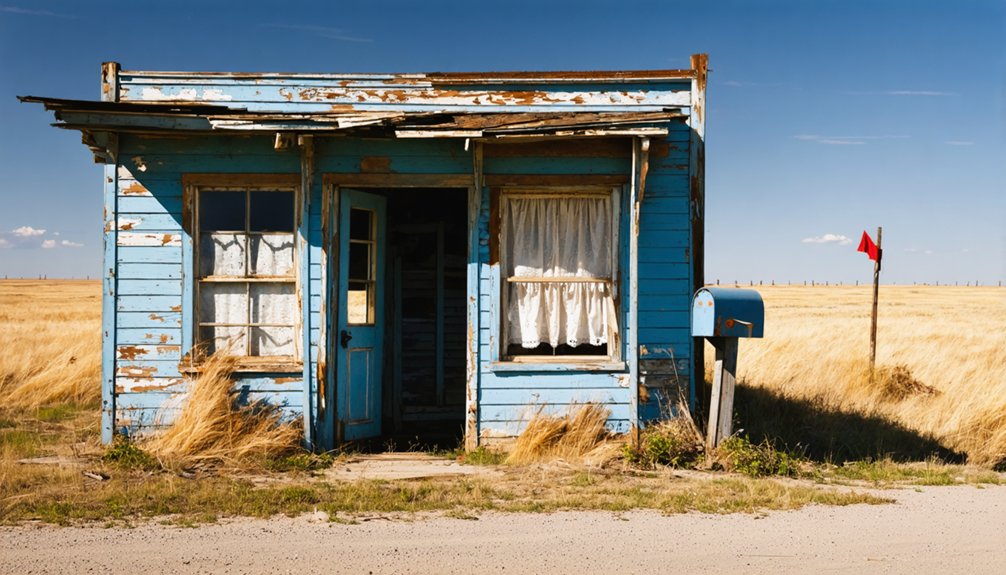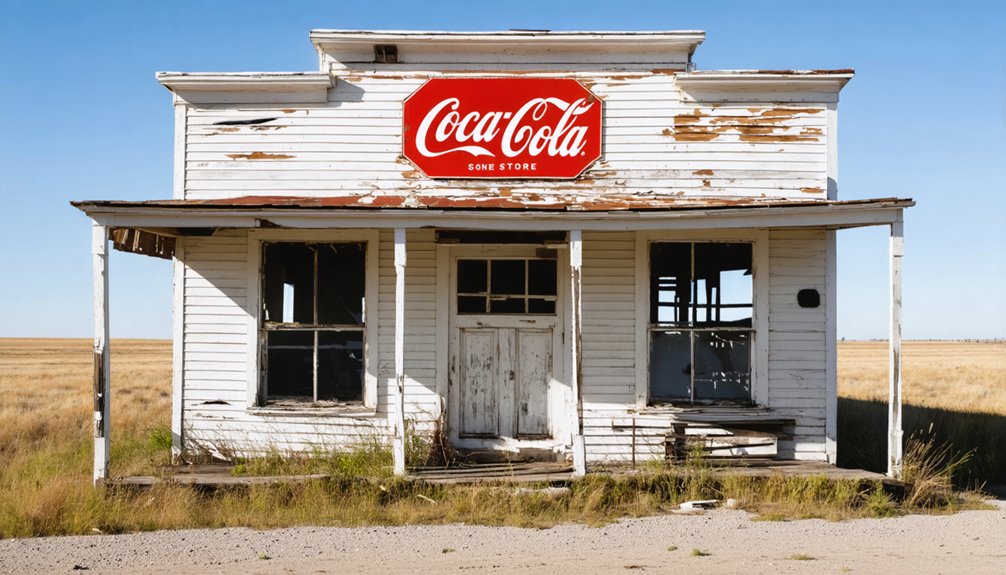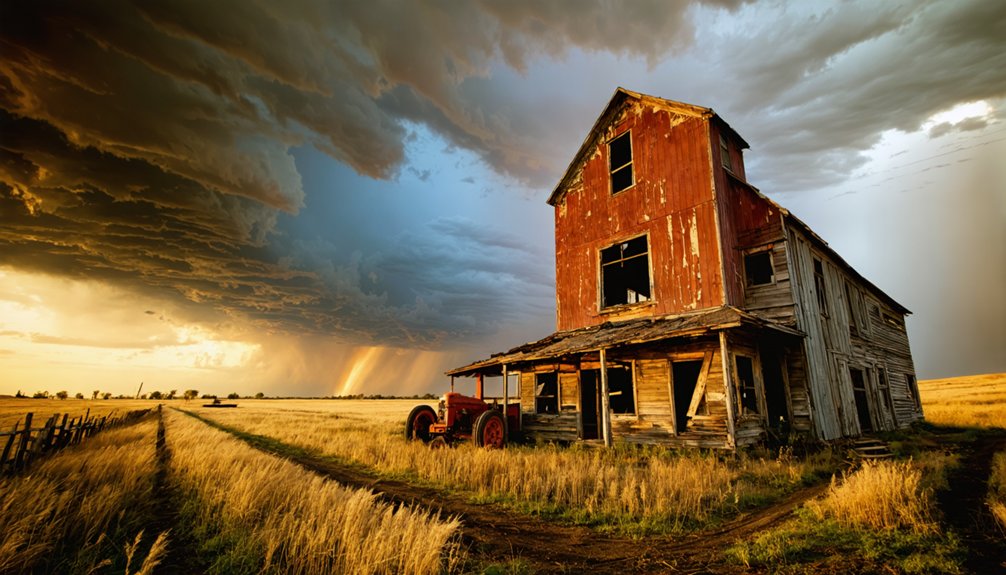You’ll find Otis tucked away in South Dakota’s Black Hills, where it once thrived during the region’s late 1800s gold rush. The town centered around coal extraction and the Otho Mine, with workers enduring grueling shifts while living in basic company housing. Families created a tight-knit community through shared meals and folklore about Tommyknockers, despite harsh conditions. The town’s transformation from bustling settlement to abandoned frontier holds deeper stories about the Black Hills’ evolution.
Key Takeaways
- Otis was a mining town in South Dakota’s Black Hills region, centered around coal extraction with basic company housing for workers.
- The community featured strong social bonds through shared meals and folklore, including beliefs about Tommyknockers in the mines.
- Daily life involved challenging mining shifts, with families living in cramped wooden homes while facing harsh working conditions.
- The town’s decline began as mining opportunities diminished, accelerated by its isolated location and the abandonment of railroad services.
- Despite attempts at tourism through ghost town attractions, Otis failed to sustain its economy and was eventually abandoned.
The Rise of a Mining Frontier
While the Black Hills had long been sacred to the Lakota people, the 1874 Custer Expedition sparked a transformative gold rush that would reshape the region’s destiny.
You’ll find that prospectors flooded the area by 1875, defying the Fort Laramie Treaty as they sought their fortunes in French Creek’s promising waters.
The early mining techniques started simply – working placer deposits in streambeds before tackling the more challenging hardrock deposits. The Golden Reward Company emerged as a dominant force in Ruby Basin by 1887, becoming second only to Homestake in gold production.
As frontier challenges mounted, settlements like Lead, Deadwood, and Terraville sprouted up virtually overnight.
The Manuel brothers’ discovery of what would become the Homestake Mine in 1876 marked a turning point, attracting corporate interests like George Hearst who’d transform small-scale prospecting into industrial-scale mining operations that would define the region for over a century. The mine would go on to produce an astounding 40 million ounces of gold throughout its operational lifetime.
Life in the Mining Community
Life in Otis centered around the daily rhythms of coal extraction, where miners descended into the earth for grueling shifts that shaped every aspect of their existence.
You’d find yourself living in basic company housing, relying on the mine store for supplies, often falling into cycles of debt. Community folklore, like leaving food for the Tommyknockers, helped miners cope with the constant dangers underground. The community eventually gave way to the State Game Lodge, marking the end of its mining era.
Miners lived at the mercy of company stores, while folklore traditions like feeding Tommyknockers provided comfort amid daily perils.
Labor struggles were part of daily life as you’d face:
- Hazardous working conditions with minimal safety measures
- Respiratory illness from constant coal dust exposure
- Economic uncertainty from boom-and-bust cycles
The largely male population lived in close quarters, finding solace in shared meals and storytelling sessions.
Despite the harsh conditions, you’d discover a tight-knit community bound together by shared risks and the unforgiving nature of mining life.
The Otho Mine Legacy
You’ll find the Otho Mine’s legacy written in its extensive network of tunnels and drifts, including a 305-foot main tunnel and seven branching passages that showcase the ambitious scale of early 1900s tin mining operations.
The mine’s economic story parallels many Black Hills ventures of its era, where substantial infrastructure investments, including ore processing equipment and carefully engineered tunnels between 1304 and 1341 meters elevation, yielded disappointing returns in tin production.
While the physical remnants, including cast iron equipment and crushed quartz mounds, tell of technological advancement, they also stand as monuments to the boom-and-bust cycle that characterized South Dakota’s mining frontier.
Mining Operations Timeline
As one of America’s pioneering tin operations, the Otho Mine emerged during the early 20th century, with its first major developments documented in Mineral Survey 2067 of 1916.
You’ll find evidence of period mining technology in its extensive network of tunnels and drifts, showcasing the era’s sophisticated tin extraction methods. The main tunnel stretched 305 feet south-southeast, while its longest drift extended 150 feet westward.
- Seven distinct drifts were developed – five on the Otho Lode and two on the Otho No. 1 Lode
- Underground operations utilized cutting-edge techniques for the time period
- Mining activities centered on tin production, setting it apart from the region’s typical gold operations
The mine’s development paralleled other Black Hills operations, though it carved its own niche in America’s tin mining history.
Economic Impact Assessment
While the Otho Mine‘s direct economic impact has faded into history, its legacy lives on through South Dakota’s modern mining renaissance.
You’ll find this heritage most prominently in projects like SURF, which is driving economic growth with a projected $1.6 billion impact through 2029. The facility’s transformation from mining to scientific research has created over 1,000 jobs statewide. The Long-Baseline Neutrino Facility contributes an additional 160 jobs annually to the region’s workforce.
The Richmond Hill Gold Project further extends this legacy, promising $400 million in state severance taxes and hundreds of high-paying positions. The project’s 2.6 million ounces of gold production over a 17-year mine life demonstrates substantial economic potential.
With its impressive 3.65 million ounces of gold resources and potential $2.1 billion NPV, you’re witnessing a region that’s successfully evolved from its mining roots.
The job creation and economic diversification have turned what could’ve been another ghost town into a thriving hub of science and technology.
Daily Operations and Commerce
Three key industries drove the daily commerce of Otis during its operational years: mining from the Otho Mine, timber processing at the local sawmill, and supporting businesses that served the workers and residents.
You’d find the town bustling with activity as workers moved between general stores, saloons, and service establishments that formed the backbone of local trade.
The town made use of tin siding on many buildings to provide comfort and familiarity to its settlers.
Similar to how Awanka once supported two hotels and churches, Otis maintained multiple establishments to serve its growing population.
- General stores supplied essential goods and mining equipment
- Hotels and lodging houses accommodated the transient workforce
- Saloons doubled as social centers, offering entertainment and gathering spaces
The town faced significant operational challenges as rail service declined.
Without reliable transportation for ore shipments and lumber products, businesses struggled to maintain supply chains.
Daily commerce gradually shifted from rail to road transport, but poor infrastructure and increasing isolation eventually led to the town’s economic downturn and ultimate abandonment.
Social Fabric and Town Culture

As a logging camp, Otis’s social life centered around the daily rhythms of timber work and the sawmill operations.
Just as small populations remain in similar abandoned towns like Okaton and Cottonwood, a few hardy residents stayed in Otis long after its peak years.
Social gatherings and dances became cherished memories for the families who once called Otis home.
You’d find workers and their families gathering informally after shifts, though specific meeting places and community centers weren’t officially documented.
While the town’s population rose and fell with the fortunes of the logging industry, families made their lives here until the camp’s eventual decline.
Mining Community Gathering Places
Mining towns in the Black Hills fostered vibrant social communities through their diverse gathering places, with establishments like Rochford’s theatres, dance halls, and the iconic Moonshine Gulch Saloon serving as cultural hubs.
These social venues weren’t just places to unwind – they were the heartbeat of community gatherings where miners and their families could escape the daily grind of mining life.
- Restored schoolhouses became centerpieces for social events and education.
- Public spaces hosted celebrations that strengthened community bonds.
- Saloons served as informal meeting halls where news and stories were shared.
You’ll find that these gathering spots played a significant role in maintaining the town’s spirit during both prosperous and challenging times.
The preservation of these historic venues today helps tell the story of how mining communities came together to create lasting social connections.
Family Life Underground
Beyond the town’s lively social venues, family life in Otis revealed a complex tapestry of daily challenges and triumphs.
You’d find families adapting to unique underground challenges, managing cramped wooden homes without modern conveniences. Family dynamics centered on survival, with men working the mines while women tackled domestic duties, from preserving food to maintaining households under harsh conditions.
Your children would’ve split their time between basic schooling and essential chores, learning life skills from both parents.
The church served as your family’s anchor, strengthening community bonds through shared worship and gatherings.
Despite the hardships of South Dakota winters and limited resources, you’d witness remarkable resilience as families supported one another, sharing resources and labor during difficult times.
The Path to Abandonment
While the gold rush era initially brought prosperity to Otis, the town’s dependence on mining operations would ultimately spell its demise. As the mines began to slow down, population shifts accelerated, with families seeking opportunities elsewhere.
Economic changes proved nearly impossible due to the town’s isolated location and harsh weather conditions. Similar to the story of Rockerville’s tourist decline, tourism initiatives in Otis struggled to attract steady visitors.
- Railroad lines serving the area were abandoned by the 1980s
- Essential services like post offices and grain elevators shut down
- Tourism attempts through ghost town attractions failed to sustain the economy
You’ll find that Otis followed a familiar pattern seen throughout the Black Hills region. Without its mining foundation, the town couldn’t maintain its infrastructure or population.
Buildings fell into disrepair, and permanent migration away from Otis became inevitable as the harsh reality of its economic limitations set in.
What Remains Today

Today at the former site of Otis, you’ll find no trace of the once-bustling logging settlement that operated here in the early 1900s. The sawmill, buildings, and roads have completely vanished from the landscape, leaving nothing behind to mark this chapter of Black Hills history.
In place of Otis’s industrial past, you’ll now discover the State Game Lodge, a symbol of the area’s transformation from logging town to recreational destination.
No foundations, artifacts, or historical markers remain to tell the story of the former community. The site’s modern usage focuses entirely on tourism and park activities within Custer State Park, and you won’t find any commemorative plaques or preserved remnants acknowledging its previous identity as a lumber town.
Historical Impact on Black Hills Region
The transformation of Otis from bustling lumber town to empty parkland mirrors the broader historical shifts that reshaped the entire Black Hills region.
You’ll find this story echoes across the landscape, where railroad expansion and resource exploitation dramatically altered both the physical terrain and cultural fabric of these sacred lands.
The impacts of this transformation continue to resonate through:
- The displacement of Lakota peoples and ongoing indigenous resilience in fighting for ancestral lands
- The boom-and-bust cycle that left behind a network of ghost towns and abandoned rail lines
- The change from extractive industries to cultural preservation efforts aimed at protecting both natural and historical resources
This pattern of development profoundly changed the Black Hills, transforming it from Lakota territory to a complex intersection of competing interests that still shapes regional politics today.
Frequently Asked Questions
Were There Any Notable Crimes or Lawless Incidents in Otis?
You won’t find records of major criminal activity or law enforcement problems in this former mining town – historical documents reveal no notable lawless incidents worth mentioning from its active years.
What Was the Average Wage of Miners Working in Otis?
You’d have found miners earning around $1.75 to $2.00 per day under tough mining conditions, though wages fluctuated based on strikes and company stability during the late 1800s in this region.
Did Any Famous People Ever Visit or Live in Otis?
Despite searching through over 100 years of records, there’s no evidence of any famous visitors or historical significance tied to this location. You won’t find any documented celebrity connections here.
Were There Any Schools or Churches Established in the Town?
You won’t find clear records of educational history or religious institutions there. While similar mining towns often had schools and churches, historical documents don’t confirm any established in this location.
What Natural Disasters or Accidents Affected the Otis Community?
Precise proof of particular disasters isn’t documented, though you’ll find regional records suggest floods and wind damage affected nearby towns. Fire incidents and weather threats were likely but aren’t specifically confirmed.
References
- https://www.sdhspress.com/journal/south-dakota-history-2-2/some-black-hills-ghost-towns-and-their-origins/vol-02-no-2-some-black-hills-ghost-towns-and-their-origins.pdf
- https://core.ac.uk/download/pdf/345016075.pdf
- https://www.youtube.com/watch?v=_0WNYsFLSLA
- https://www.youtube.com/watch?v=uCaj6m8TXv4
- https://www.blackhillsbadlands.com/blog/post/old-west-legends-mines-ghost-towns-route-reimagined/
- https://en.wikipedia.org/wiki/List_of_ghost_towns_in_South_Dakota
- https://ruralresurrection.com/ghost-towns-mystic-south-dakota/
- https://www.1880town.com
- https://history.sd.gov/museum/docs/Mining.pdf
- https://danr.sd.gov/Environment/MineralsMining/MiningHistory.aspx



